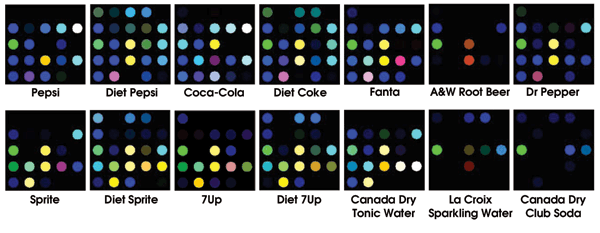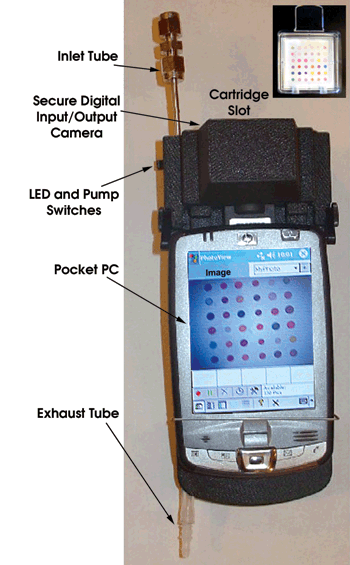Hank Hogan, Contributing Editor
Flat soda tastes different from fresh, and Kenneth S. Suslick, a chemistry professor at the University of Illinois at Urbana-Champaign, has the pictures to prove it. The loss of carbon dioxide can clearly be detected in the output of a color-based chemical sensor that he and his research team have developed. The sensor and associated analysis methods also can classify unknown soft drinks with a high degree of accuracy.
The makeup of a soft drink traditionally has been determined on a component-by-component basis using such techniques as liquid chromatography, an expensive and time-consuming approach that has the advantage of potentially yielding a fairly precise answer.

In these false-color images of a colorimetric sensor array, various soft drinks have distinct appearances. Each dot is a chemically responsive dye that reacts to exposure to the soda. These images show the calculated differences in color before and after exposure. Reprinted with permission of the Journal of Agricultural and Food Chemistry.
More recently, less expensive and faster approaches have been developed. Dubbed electronic tongues, these use an array of sensors, with various individual sensor types responding similarly to a given chemical component. Just as with organic tongues, it is the composite response — the pattern of reaction — that differentiates one drink from another. However, electronic tongues cannot discriminate among sodas and are expensive and not portable.
For the past few years, Suslick and his group have been working on an approach based on colorimetric arrays. Fabricated using chemically responsive dyes that undergo a color change because of intermolecular interactions, these arrays offer several advantages: They are inexpensive, and because they are one-time-use devices, no calibration is needed. They make use of a wide range of intermolecular interactions and do not rely solely on relatively weak physical adsorption, as other sensors do.

With this prototype handheld unit, the user can visualize what a substance tastes like as well as its chemical makeup. Sample enters the inlet tube, then causes changes in a colorimetric array (inset) that is mounted in a slot. The changes are detected by a digital camera, and the differences in colors before and after exposure are displayed on a pocket PC, providing a visual indication of the sample’s chemical fingerprint. Courtesy of Kenneth S. Suslick, University of Illinois at Urbana-Champaign.
Several years ago, Suslick founded a company to commercialize the technology for detection of disease at an early stage. But he also has applied it to discriminating among various beverages, including beer . Sensors for beer and soft drinks use similar setups, although minor changes are needed to account for soda characteristics. “The array was tweaked a bit to deal with the greater acidity of soft drinks,” Suslick said.
In the soda sensor, the researchers used a set of 25 chemically responsive dyes, printed in an array of dots on a hydrophobic membrane. They saturated the arrays with an aqueous liquid that had no dissolved organics and then used an inexpensive flatbed scanner from Epson America Inc. of Long Beach, Calif., to measure the red, green and blue values of each dot. They exposed the sensor to one of 14 soft drinks, measuring the color components of each dot and calculating the difference for each of the three components for every 10-pixel-radius spot, averaging these over the four sensors that they used for each drink. The research is reported in the Jan. 24 issue of the Journal of Agricultural and Food Chemistry.
The resulting difference maps clearly showed that the various sodas had distinct profiles, which the researchers made more easily visible by extending the color range to a full 8-bit value. When performing data analysis, they used the raw 5-bit values, creating 75-dimensional vectors that described the profiles.
For the assay, they used a principal component analysis technique that concentrates the variations among sodas into the fewest number of dimensions, or principal components. Generally, the larger the number of principal components needed to account for a given level of data variability, the better the sensor discrimination.
In the case of sodas, the researchers found that 15 dimensions were required to account for 95 percent of the variation. In contrast, they noted that electronic noses and tongues hit the same number in their first two dimensions.
The group found that the soda profiles are a function of their flavorings, water content and degrees of acidity and of carbonation. “The identification is not dominated by pH, but rather from many contributions, pH among them,” Suslick said.
Therefore, for example, the technique can determine whether soft drinks have been diluted by water. This, Suslick noted, is not usually a problem with products from the manufacturer. Instead, it shows up when the drink is made on-site by combining flavored syrup, carbon dioxide and water. “The biggest problem is actually with fountain dispensers,” he said.
The glitch, he added, can be inadvertent or the result of a deliberate attempt to save money by skimping on ingredients. A local lack of quality can have a more widespread impact, he said. “Manufacturers worry about having their brand name associated with an inferior serving.”
The researchers have developed a handheld analyzer, which, while not yet perfected, is functional. They also are working on using noncontact bioarray printers that will enable more uniform and smaller arrays. However, it is unclear when — or if — the technique will be used for quality control and quality assurance in soda manufacturering and elsewhere.
Contact: Kenneth S. Suslick, School of Chemical Sciences, University of Illinois at Urbana-Champaign; e-mail: [email protected].